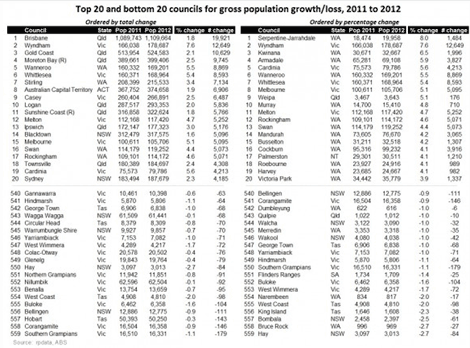Australia's four biggest capital cities are dominating national population growth: Tim Lawless

Most people wouldn’t have heard of Bruce Rock. I asked my wife and she thought it might be the name of a rock singer (that’s Kid Rock…). Bruce Rock is actually a council region located 254 km east of Perth. According to the Bruce Rock council web site, it’s quite a nice place to visit:
The Shire of Bruce Rock and its townsite are situated in the heart of the Wheatbelt, 254km east of Perth. It has a population of approximately 700 people, with 1200 people in the shire. Bruce Rock ‘leads the way’ to open spaces and an agricultural experience to be enjoyed by all. We welcome visitors to enjoy the picturesque main street, gardens, amphitheatre and sculpture park, historic buildings, museums, federation style verandahs and great facilities.
Unfortunately, it’s also one of two council’s recording the fastest rate of population decline over the past year. According to the recently released regional population statistics from the Australian Bureau of Statistics, the population of Bruce Rock fell by 2.7% over the year to June 2012. In raw number terms that equated to a loss of only 27 people; but when you have a population of less than 1,000 people to begin with, I’m guessing you would want to retain as many people as possible.
The council region of Hay, located in the Riverina region of NSW, also recorded a decline of 2.7% in population over the year to June 2012. Hay is quite a bit larger than Bruce Rock with an estimated residential population of 3,013 residents (that’s taking into account the 84 fewer people over the year). Hay Shire is noted as being one of the flattest places on earth. More importantly, the region is part of one of the most important agricultural centres in the country.
Click to enlargeLooking across the council regions that have recorded the most significant rate of population decline it shouldn’t come as a surprise that they are generally rural locations and more often than not, they have an economy centred around agriculture with tourism often cited as a secondary industry.
I suspect the challenge for these regional communities is retaining the younger cohorts of the population. A quick look at the Census data for the top five council regions based on the largest percentage fall in population shows an average age which is considerably higher than the national average which supports this notion. There has been plenty of research done on the regional population drain across Australia which a Google search will uncover.
As an aside, I thought this article from Computerworld titled ‘NBN to stop the rural brain drain’ was quite an interesting perspective on one of the benefits of how high speed internet access may help to sustain populations across regional communities.Looking at areas where population growth has been the fastest, the regions tend to be across the outskirts of the capital cities and to a lesser extent the inner city areas where densification is driving population growth. The fastest growing council region in the country is the Shire of Serpentine-Jarrahdale located on the outer southern fringe of the Perth metro area. In fact, thirteen of the top 20 fastest growing council regions are located in Western Australia.
From a wider perspective, comparing the capital cities and regional areas across the country, the four largest capital cities (Melbourne, Perth, Sydney and Brisbane) are recording the vast majority of Australia’s population. In fact, 69% of the national population growth over the year to June 2012 was centred within these four cities.
Click to enlargeIn percentage terms, the Greater Perth region is punching well above its weight, recording population growth of 3.6% over the year to June 2012. The other regions recording a rapid rate of population growth are the regional areas of Western Australia, Darwin and Brisbane where the growth rate is higher than 2%.
Just like a declining population poses challenges, so too does a rapidly growing one. Delivering sufficient infrastructure is always the pain point for regions where population growth is strong. Pressure for new roads, bridges, public transport, schools and hospitals are high on the agenda in any of these regions and state and local governments are constantly challenged to deliver what is required.
If you’re interested in what is happening with population growth trends, I’ve put together a series of thematic maps based on SA2 boundareis that highlight where population growth is occurring and where are the areas experiencing a population drain.
This key (pictured below) indicates the rate of population growth from 2011 to 2012:
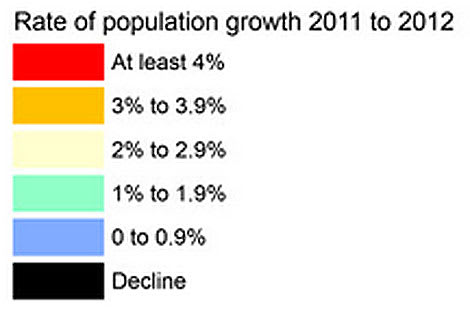

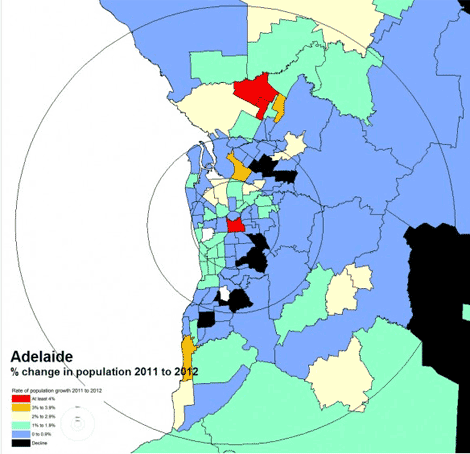
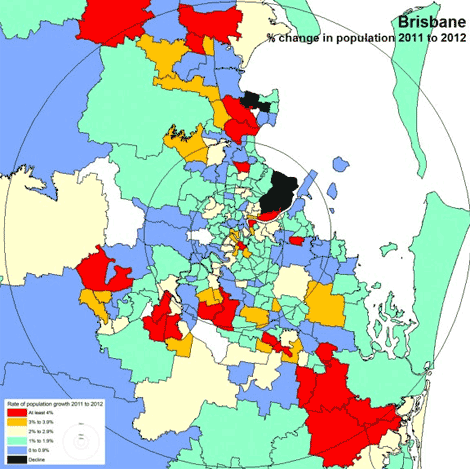
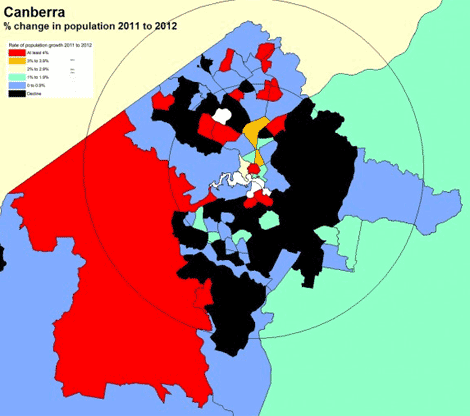
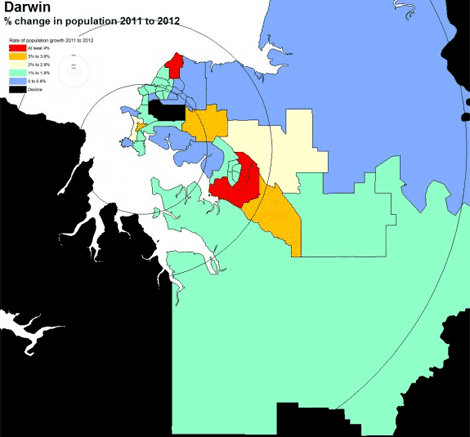
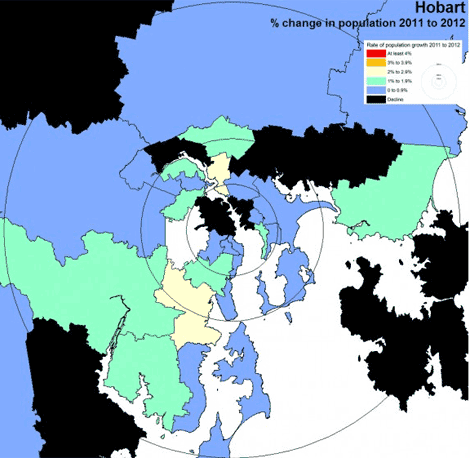
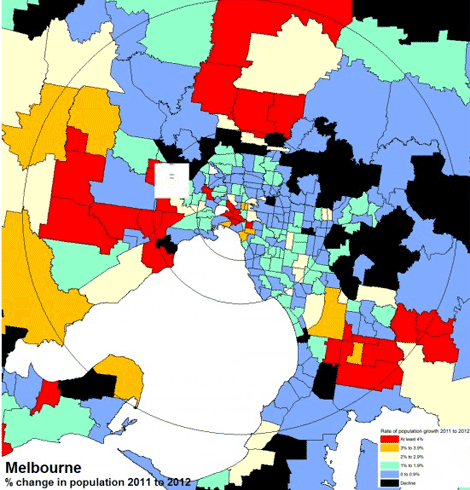
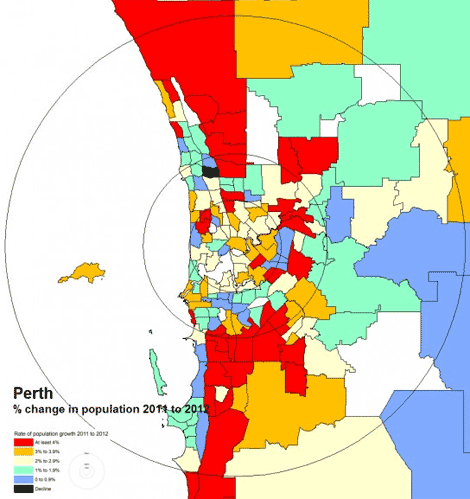
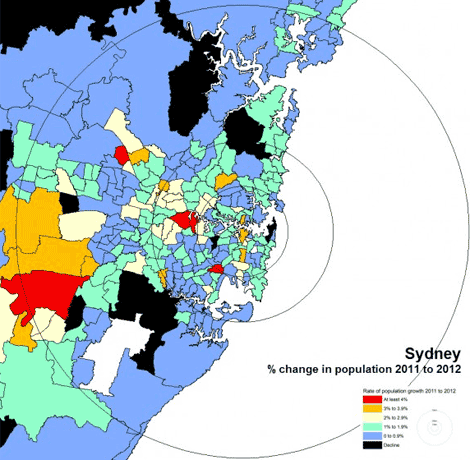
Tim Lawless is national research director of RP Data.
